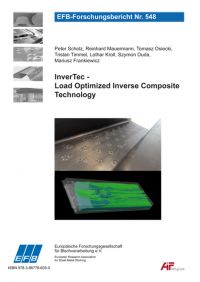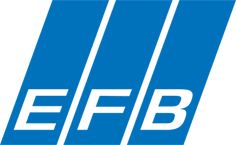InverTec - Load Optimized Inverse Composite Technology

Authors:
M. Sc. Peter Scholz, Prof. Dr.-Ing. Reinhard Mauermann, Fraunhofer Institute for Machine Tools and Forming Technology Chemnitz - M. Eng. Tomasz Osiecki, M. Sc. Tristan Timmel, Prof. Dr.-Ing. Lothar Kroll, Department of Lightweight Structures and Polymer Technology at the Institute of Lightweight Structures, Chemnitz University of Technology - M.Sc. Szymon Duda, Dr.-Ing. Mariusz Frankiewicz, Laboratory of Functional Coatings at the Mechanical Engineering Department, Wroclaw University of Science and Technology
118 Pages - 82,00 EUR (bw, 71 partly colored Figures, 14 Tables)
ISBN 978-3-86776-605-0
Summary
Within the framework of the European joint research project, the project consortium consisting of the Fraunhofer Institute for Machine Tools and Forming Technology IWU together with the Chair of Lightweight Structures and Plastics Processing (SLK) at Chemnitz University of Technology and the Wroclaw University of Science and Technology (WUST) is working on the development of a new type of composite, that is designed to withstand high loads, consisting of a continuous fiber-reinforced thermoplastic matrix into which a metallic insert is inserted.
In addition to improving crash performance, the metallic insert is also to be used to effectively connect the composite to adjacent metallic structures. Conventional methods of sheet metal processing are to be used for the efficient, large-scale production of the novel composite.
To improve the connection between the metallic insert and the fiber-reinforced plastic (FRP), an innovative combination of mechanical form-fit and adhesive bonding is aimed at. Thereby, the form-fit is realized by the integration of interlocking elements in the metal insert and the adhesive bond is realized by a coating of the metallic insert.
Parallel to this, a testing device with flexible clamping elements is being developed, which will enable application-oriented component testing under dynamic loads.
Based on these fundamentals, Fraunhofer IWU has defined and manufactured several form-fit elements, which have the desired combination of properties (e.g. isotropy, Interlocking of fibers in case of a crash, producible with conventional punching technology).
In parallel, SLK developed a stiffness-optimized and application-specific layer structure, consisting of a combination of carbon and glass fiber reinforced prepregs with additional Polyamide (PA6) layers, in order to achieve a sufficient filling level of the structures inserted into the metallic insert.
For a realistic evaluation of the composite performance of the different interface concepts, WUST developed a test device that allowed the crash properties of the inserted structures under dynamic stress to be determined in a manner close to the application.
Using a scaled roof cross member of a car as a demonstrator component, the advantages of the novel joining technology could be demonstrated. Finally, a profitability analysis was conducted for the developed component variants of the roof cross member.
In summary, it can be stated that an efficient method was developed on the basis of the project results, which enables the industry to produce hybrid composites with excellent composite strength and crash performance.
The interlocking of the fibers of the FRP with the forming induced form-fit elements leads to a significant increase in energy dissipation in the event of a crash. Compared to the steel reference, the component weight could be reduced by 40% with improved mechanical properties.
Funding Reference
The publication "InverTec - Load Optimized Inverse Composite Technology" (Belastungsoptimierte inverse Hybridtechnologie) shows the results of the industrial research project EFB/AiF-Nr: 204EBR, that was supervised by the EFB European Research Association for Sheet Metal Working (Europäische Forschungsgesellschaft für Blechverarbeitung e.V.) Hannover and the CINNOMATECH - Cluster of Innovative Manufacturing Technologies Wroclaw.
The project was supervised by the EFB. In the scope of the CORNET - European Research Programme it was funded by the German Federal Ministry for Economic Affairs and Energy via the Federation of Industrial Research Associations (AiF - Arbeitsgemeinschaft industrieller Forschungsvereinigungen e.V.) on the basis of a decision by the German Bundestag. The results are edited by EFB-Verlag as EFB-Research Report No. 548.
Zusammenfassung
Belastungsoptimierte inverse Hybridtechnologie
Im Rahmen des europäischen Gemeinschaftsforschungsprojektes beschäftigt sich das Pro-jektkonsortium bestehend aus dem Fraunhofer-Institut für Werkzeugmaschinen und Um-formtechnik IWU zusammen mit der Professur Strukturleichtbau und Kunststoffverarbeitung (SLK) der Technischen Universität Chemnitz und der Wroclaw University of Science and Technology (WUST) mit der Entwicklung eines neuartigen belastungsgerecht gestalteten Verbundtyps, der aus einer endlosfaserverstärkten thermoplastischen Kunststoffmatrix besteht, in die ein metallischer Einleger eingebracht wird.
Neben der Verbesserung der Crashperformance soll der metallische Einleger zusätzlich auch zur effektiven Anbindung des Verbundes an angrenzende metallische Strukturen genutzt werden. Zur effizienten, großserienfähigen Herstellung des neuartigen Verbundes sollen konventionelle Methoden der Blechbearbeitung eingesetzt werden.
Zur Verbesserung der Anbindung zwischen dem metallischen Einleger und dem faserver-stärktem Kunststoff (FKV) wird eine innovative Kombination aus Form- und Stoffschluss angestrebt. Dabei wird der Formschluss durch das Einbringen von Formschlusselementen in den metallischen Einleger und der Stoffschluss durch eine Beschichtung des metallischen Einlegers realisiert. Parallel dazu wird ein Prüfvorrichtung mit nachgiebigen Einspannstellen entwickelt, die es ermöglicht eine anwendungsnahe Bauteilprüfung unter dynamischer Be-anspruchung durchzuführen.
Aufbauend auf diesen Grundlagen wurden vom Fraunhofer IWU mehrere umformtechnisch hergestellte Krafteinleitungsstrukturen definiert und hergestellt, welche die gewünschten Eigenschaftskombinationen (z. B. Isotropie, verhaken mit Fasern im Crashfall, herstellbar mit konventioneller Stanztechnologie) aufweisen.
Parallel dazu entwickelte die TU Chemnitz einen steifigkeitsoptimierten und auf den Anwen-dungsfall abgestimmten Lagenaufbau, bestehend aus einer Kombination von kohlenstoff- und glasfaserverstärkten Einzellagen mit zusätzlichen Polyamid (PA6) Lagen, um einen ausreichenden Füllgrad der in den metallischen Einleger eingebrachten Strukturen zu erzielen.
Zur realitätsnahen Bewertung der Verbundperformance der verschiedenen Interfacekonzepte wurde durch die Wroclaw University of Science and Technology eine Prüfvorrichtung entwickelt, mit dessen Hilfe die Crasheigenschaften der eingebrachten Strukturen unter dynamischer Beanspruchung anwendungsnah bestimmt werden konnte.
Anhand eines skalierten Pkw-Dachquerträger als Demonstratorbauteils konnten die Vorzüge der neuartigen Verbindungstechnik nachgewiesen werden. Abschließend wurde für die entwickelten Bauteilvarianten des Dachquerträgers eine Wirtschaftlichkeitsanalyse durchgeführt.
Zusammenfassend kann festgestellt werden, dass auf Basis der Projektergebnisse eine effiziente Methode entwickelt wurde, die es der Industrie ermöglicht Hybrid-Verbunde mit einer ausgezeichneten Verbundfestigkeit und exzellenter Crashperformance herzustellen.
Die Verklammerung der Fasern des FKV mit den umformtechnisch eingebrachten Form-schlusselementen führt zu einer deutlichen Erhöhung der Energiedissipation im Crashfall. Im Vergleich zur Stahl-Referenz konnte das Bauteilgewicht bei verbesserten mechanischen Eigenschaften um 40 % reduziert werden.
Table of contents
Zusammenfassung
List of figures
List of tables
1 Introduction
2 State of the art
2.1 Self-pierce riveting
2.2 Clinching
2.3 Flow curve determination for mechanical joining
2.4 Large strain flow curve of sheet metal
2.4.1 Large strain flow curve
2.4.2 Identification Methods for acquiring large strain flow curves
3 Problem and research objective
4 Materials, equipment and tools
4.1 Investigated materials
4.2 Joining setup
4.3 Joining elements and tools
4.3.1 Self-pierce riveting
4.3.2 Clinch forming
5 Experimental joint analysis
5.1 Procedure
5.2 Self-pierce riveting
5.3 Clinching
6 Simulation models of the joining processes
7 Material testing requirements for joining by forming
7.1 Plastic anisotropy
7.2 Large strain flow curve
7.3 Strain rate effect
7.3.1 Numerical
7.3.2 Experimental
7.4 Conclusions
7.4.1 Plastic Anisotropy
7.4.2 Flow curve data
8 Material characterization methods
8.1 Tensile test
8.2 Extended tensile test
8.3 Stack compression test (SCT)
8.4 Plane strain compression test (PSCT)
8.5 In-plane torsion test (IPPT)
8.6 Hydraulic bulge test (HBT)
9 Numerical stress analysis
9.1 Stress-state metric
9.2 Process-informed method selection
9.3 Clinching
9.4 Self-pierce riveting
9.5 Material characterization tests
9.5.1 Extended Tensile Test
9.5.2 Stack compression test
9.5.3 Plane strain compression test
9.5.4 In-plane torsion test
9.5.5 Hydraulic bulge test
9.5.6 Summary
9.6 Comparison of joining processes and material tests
10 Experimental and numerical study of the stack compression test
10.1 Initial state and parameters of the stack compression test
10.2 Manufacturing process of the discs
10.3 Influence and correction of friction
10.4 Influence of diameter and number of discs
10.5 Influence of a shift in hydrostatic pressure
10.5.1 Experimental
10.6 Round Robin test
10.6.1 KUL experiments
10.6.2 Comparison of IWU and KUL experiments
11 Evaluation of flow curves from considered material tests
11.1 Flow curve extrapolation
11.2 Flow curve comparison
12 Determination of flow curves for SPR-ST rivets
13 Numerical assessment of flow curves
13.1 Flow curve comparison for self-pierce riveting
13.2 Flow curve comparison for clinching
14 Recommendations for flow curve determination for mechanical joining
15 Project Results
16 List of Literature
17 Attachments

